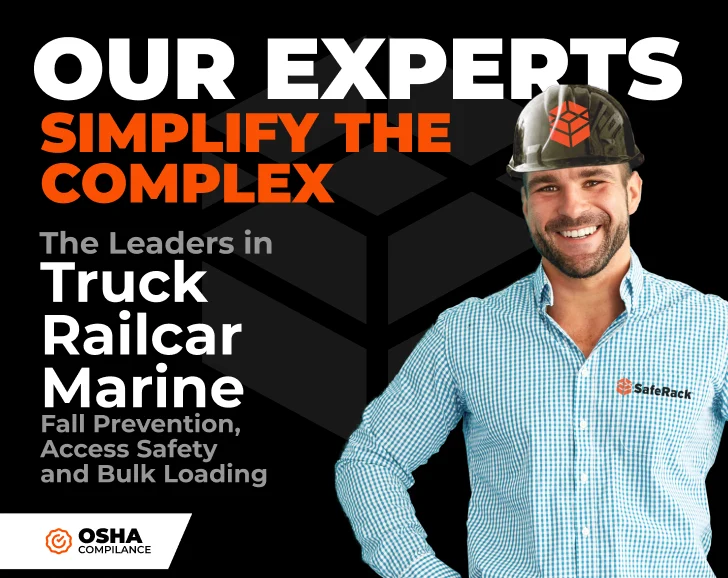Episode #2 – Railcar Loading BOLOs
Things to Be-On-the-Look-Out for when determining the best railcar loading solution
It’s not uncommon for customers in the railcar loading industry to come to us with a long list of questions about the specifications required for their application. Railcars are rarely uniform with length and heights varying widely depending upon the material and quantity being transported. Thankfully, we serve just about any industry from hazardous chemical and aggregate to food and beverage and oil and gas with proactive safety solutions to improve safety and increase efficiency in railcar loading/unloading operations.
In this episode of the SafeRack Podcast, hosts Kenny Rogers and Ray Evans discuss the variables which must be considered when designing a safe and effective railcar loading solution. From tight fill for pressurized materials such as ammonium sulfate and chlorine to splash fill loading for food-grade products such as vegetable oil and corn syrup, Vertical Market Specialists Kenny and Ray cover common obstacles in railcar loading. Topics include the pitfalls of narrow gangways and how to accommodate the need for bulky PPE or piping or conduit obstructions when preparing to install or retrofit a railcar loading solution in any industry.
 KENNY ROGERS
KENNY ROGERS
SafeRack’s Cement, Mining & Flatbed Fall Protection Specialist
An industry expert with 20 years of successful experience in business development and project management, Kenny has the ability to provide progressive, out-of-the-box solutions on complex plant projects.
 RAY EVANS
RAY EVANS
SafeRack’s Bulk Chemical Market Specialist
With over 25 years of experience, Ray has been instrumental in collaborating with the top Bulk Chemical companies and works closely with local and national chemical trade associations keeping abreast of the latest legislative news and initiatives in the Agro Chem/Fertilizer, Petro, and Specialty Chemical space.
Podcasts
- Truck spotting with Kenny and Ray
The significance of proper truck spotting includes topics such as loading arms and hoses, open and closed loading, ISOtainers, specialized safety cages, hatch access, as well as top and bottom unloading from truck and rail. - Railcar Loading BOLOs
A discussion about the variables to consider when designing a safe and effective railcar loading solution - Design-Build Services
Explore the wide variety of loading and safe access applications we deliver. From simple loading spot upgrades and turn-key installations to more complex retrofits and complete rail, marine, and truck loading/unloading systems, the duo covers common concerns and requirements customers face when considering an install. - Soft Tissue Injuries
Solutions for avoiding the most common workplace injury, soft tissue damage to muscles, tendons, and ligaments. - Preparing for Modular Stair & Ramp Installation
Guest hosts Billy Lippert and Eli Boyd from Upside Innovations discuss how the Apex System makes ramp deck step installations straightforward and successful.
Podcast Transcript
Kenny
Welcome To another edition of the SafeRack podcast. I’m Kenny Rogers, Cement, Mining & Flatbed Fall Protection vertical market specialist.
Ray
And I’m Ray Evans, vertical market specialist for Bulk Chemical.
Kenny
Today we’re going to talk a little bit about railcar BOLOs. A lot of customers call in and want to have. They have a lot of questions on hey you know I’ve got this railcar application what do I need to have safe access and loading at these locations. And a lot of times you know what we’ll see is that you know they don’t know what they don’t know.
Ray
Exactly. A lot of times I hear my railcars are all the same, but we know they’re not the same. Right?
Kenny
Right. very rarely is there a dedicated fleet of railcars for a particular application.
Ray
Exactly. Yeah. Most people don’t realize that railcars come in various lengths and sizes, and it also depends on the product or commodity that you’re transporting. Some of your dedicated cars, like an ammonia railcar might be a smaller 45-footer with a 10,000-gallon capacity, or as large as a 33,000-gallon LPG railcar.
Kenny
So obviously different lengths, different heights and different crash box designs for these various railcar applications.

Ray
It’s really based on the commodity that you’re transporting. Some cars are, are tight fill (or closed loading) and some are splash loaded. So it’s going to be a tight fill , which is typically a pressurized railcar. In a pressurized railcar, they’re going to be transporting hazardous materials such as ammonium nitrate, which might be chlorine, ethylene oxide, LPG or maybe vinyl chloride. Also, railcars can be insulated or not insulated, depending on the product.
Kenny
So there you’ll have safety valves, and tight fuel connections, whereas you could have these railcars that have splash loaded, which you don’t have the same needs or requirements for those applications.
Ray
Correct. They could be splash loaded, could be edible oils or fuel oils, or things of that nature.
Ray
When we’re dealing with a pressurized car, there won’t be a man way as with non-pressurized railcars, but they’ll have a breadbasket where you make your connections in there and a smaller crash box of six by six.
Ray
When you’re dealing with a non-pressurized railcar, you’ll see longer crash boxes for your man ways and a bread basket for loading with a tight seal or splash seal.
Kenny
Yeah. A lot of times with these types of railcars, you’ll see that they have the offsets and there are some special design criteria that we like to design, helping people safely access these railcars. What are some different types of solutions that you’re seeing out there?
Ray
Well, with these offset crash blocks, we typically want to put in a wider gangway, if possible. In the old days before where they had safety cages, you would just have a little pivoting gangway that would pivot to the opening. But that’s not the best, approach because the worker will have to hop over a handrail just to get access to the railcar. That’s not really best practice,
Kenny
Yeah. I mean, you’re creating more of an unsafe condition by having to jump over that crash box versus just going up the side of the railcar.
Ray
Right. And then depending on the size of your safety cage, the cage could interfere with your connections as well.
Kenny
Right. If you can’t open the hatches, you can’t make connections to the loading apparatus, whether it’s a tight fill or splash fill. So it does create a host of issues if you don’t have the right gangways in there.
Ray
So what we like to recommend is, to provide a safer, more effective loading operation is put in a wider gangway, so increase a standard 4-foot wide gangway to a 5 or 6-foot wide gangway.
(Self-Adjusting Stairs) | (Self-Adjusting Stairs) | (Flat Ramp Loading) | (Telescoping Flat Ramp) | |
| Vehicle(s) | Truck loading | Truck loading | Loading Hopper RailCars | Loading Liquid Tank RailCars |
| Attributes | Easily Adjusts to different vehicle heights | Easily Adjusts to different vehicle heights | Telescoping extension to adjust for Railcar crash boxes or applications that don’t require safety cage | |
| Width/ Range | 24″, 36″, 48″, 60″, 72″ 45° Up/40° Down | 24″, 36″, 48″, 60″, 72″ 45° Up/40° Down | 24″, 36″, 48″, 60″, 72″ 15° Up/15° Down | 24″, 36″, 48″, 60″, 72″ 15° Up/15° Down |
| Options | Safety Cage Power Options: Pneumatic, Corrosion Resistant Pneumatic, 110V (via 12 volt system), Solar (via 12 volt system), 208V (without 12 volt system) | Safety Cage | Safety Cage | |
| Load | 500lbs | 500lbs | ||
| Materials | Aluminum with stainless steel hardware | Aluminum with stainless steel hardware | Aluminum with stainless steel hardware. Stainless steel option | Aluminum with stainless steel hardware. Stainless steel option |
Kenny
Whenever the railcar comes in, whether it’s offset left or right, it can come in out of the way, and then it can, it can obviously solve that issue. But on another level, if the, if it’s a hazardous application and the people accessing the top of railcar have on PPE, which is kind of bulky sometimes with goggles, respirators, and Tyvek suits, it’s difficult with the smaller gangways to access the railcars.
Ray
Exactly. So that’s why I said a minimum of 48 inches wide is what we’re looking for. What we’re looking for. So a two-rail cage design has been industry standard for a long, long time. But now companies are being more proactive and they want to close off that gap and reduce it to less than 19 inches. So we (SafeRack) got a couple of solutions that are out there in the industry. We have a four-rail cage that articulates down with the gangway. Basically, it’s like a two-rail cage on steroids, which is like a two-rail cage design and with “flappers” on the inboard on the outboard side that kind of fold down and close off the gaps on the inboard on the outboard side.
SafeRack Safety Cage Types
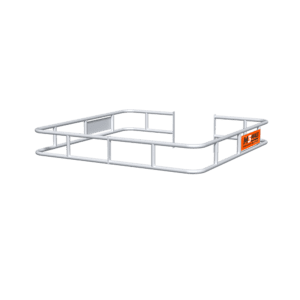 | 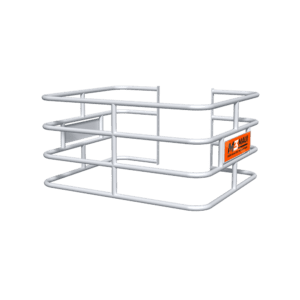 | 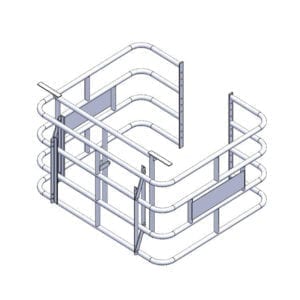 | 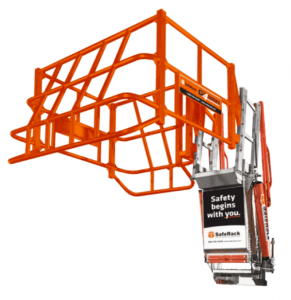 | 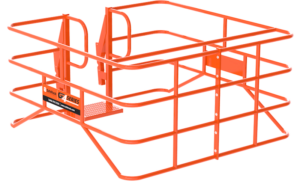 |
| 2-Rail Safety Cage | 4-Rail Safety Cage | ISOtainer Safety Cage | Offset Safety Cage | FracSand Cage |
Kenny
So whenever you’re having one of these cages access on a safe access gangway, it works in an arc motion, which is why you have to have that flapper on the outside versus a vertical motion for an elevated cage.
Ray
Correct. With crash boxes in one particular plant, you might have a 6×6’ or maybe all the way up to a 7×6’ crashbox, need to make sure that cage comes down, that if you just come straight down, you could actually hit the outboard rail so we have cages that fold down, resting on top of the cashbox.
Kenny
What about retrofitting existing structures? You know, a lot of times those installations are a little bit bigger. Is there are there any issues that you see whenever you’re putting these gangways and cages with some existing locations?
Ray
Yeah. One thing you need, it does take up a little more real estate on the face of the platform. So could be anywhere from six to seven feet depending on the size of the gangway. If you’ve got processed pipe there, the nitrogen lines or whatever that you can’t move. We do have another solution that’s out there in the industry, and that’s going to be a four-rail elevating cage. It’s a freestanding system. We’re going to drop, supports to grade, and you don’t have to worry about what’s on the face of your platform.
Kenny
Yeah, because a lot of times if they have to relocate an installation due to process piping, conduit, or other obstacles, it’s an expensive proposition. Relocating could be more than the cost of our equipment.
Ray
Absolutely. And then with these elevating cages, it can be powered with hydraulics, pneumatics, or electricity with options for non-explosion or explosion-proof.
Kenny
So a summary of today’s discussion… we talked about the BOLOs that are out there. We get a lot of calls from customers about an application with a lot of congestion or obstructions in front of their loading platform and we’ll have to do on-site to evaluate and consider the BOLOs.
Ray
Absolutely. With SafeRack, we’ve got a dedicated sales team and experts that can do a turnkey and ensure you have a successful project.
Kenny
That’s all the time we have for today’s podcast. Join us next time when we discuss design, build services.



















